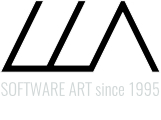Generative application
Text
Resistance
Much of LIA’s early works, programmed in Macromedia Director and accessible online using the Shockwave plugin, are currently inaccessible. If the webpages are in many cases still online, current browsers lack the necessary support to properly run them, so while the works still exist, they’re technologically sequestered.
“Resistance”, LIA’s new piece, uses FRAMED*’s technological context to revisit and reimagine some of her approaches in re-move.org and turux.at, not by rebuilding any one of those pieces, but rather by reenacting processes that were often used in those series of works.
In “Resistance” we can find several moving elements with trails, black squares that continuously swipe the screen vertically, leaving a stream of markings in all positions they visited. As every time one of these cycles ends the element randomly chooses a new horizontal position, the iteration of these cycles would inevitably conduce to a totally black screen. Atop of these elements, a big orange square also moves around, exhibiting a behaviour that’s not unlike that of all other elements. This square, however, does not leave a trail but rather deletes those left by all other elements.
No matter how hard the orange rectangle tries to erase the many black markings left in the canvas, black pieces keep industriously moving. Depending on how they interact sometimes we may be led to believe that the orange square is getting ahead, sometimes the opposite happens.
The extreme formal minimalism of “Resistance” also brings us back to LIA’s early works. Once more we have a LIA piece that is minimal to the extreme in its basic surface elements, but that through their elements’ motions and behaviours, builds complex dynamics and ever-shifting compositions. It is with these dynamics that LIA builds elaborate experiences, that develop gnarly narratives that may alternatively be seen as expressing political stances, declaring principles, or simply, perhaps, as gateways for introspection.
// Text: Miguel Carvalhais, Porto, 2017
